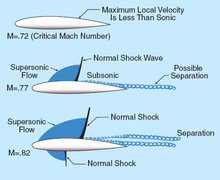- Critical Mach number
-
In aerodynamics, the critical Mach number (Mcr) of an aircraft is the lowest Mach number at which the airflow over any part of the aircraft reaches the speed of sound.[1]
For all aircraft in flight, the airflow around the aircraft is not exactly the same as the airspeed of the aircraft due to the airflow speeding up and slowing down to travel around the aircraft structure. At the Critical Mach number, local airflow in some areas near the airframe reaches the speed of sound, even though the aircraft itself has an airspeed lower than Mach 1.0. This creates a weak shock wave. At speeds faster than the Critical Mach number:
- drag coefficient increases suddenly, causing dramatically increased drag [2]
- in aircraft not designed for transonic or supersonic speeds, changes to the airflow over the flight control surfaces lead to deterioration in control of the aircraft.[2]
In aircraft not designed to fly at the Critical Mach number, shock waves in the flow over the wing and tailplane were sufficient to stall the wing, make control surfaces ineffective or lead to loss of control such as Mach tuck. The phenomena associated with problems at the Critical Mach number became known as compressibility. Compressibility led to a number of accidents involving high-speed military and experimental aircraft in the 1930s and 1940s.
Although unknown at the time, compressibility was the cause of the phenomenon known as the sound barrier. Subsonic aircraft such as the Supermarine Spitfire, BF 109, P-51 Mustang, Gloster Meteor, Me 262, P-80 have relatively thick, unswept wings and are incapable of reaching Mach 1.0. In 1947, Chuck Yeager flew the Bell X-1 to Mach 1.0 and beyond, and the sound barrier was finally broken.
Early transonic military aircraft such as the Hawker Hunter and F-86 Sabre were designed to fly satisfactorily faster than their Critical Mach number. They did not possess sufficient engine thrust to reach Mach 1.0 in level flight but could be dived to Mach 1.0 and beyond, and remain controllable. Modern passenger-carrying jet aircraft such as Airbus and Boeing aircraft have Maximum Operating Mach numbers slower than Mach 1.0.
Supersonic aircraft, such as Concorde, the English Electric Lightning, Lockheed F-104, Dassault Mirage III, and MiG 21 are designed to exceed Mach 1.0 in level flight. They have very thin wings. Their Critical Mach numbers are higher than those of subsonic and transonic aircraft but less than Mach 1.0.
The actual Critical Mach number varies from wing to wing. In general a thicker wing will have a lower Critical Mach number, because a thicker wing accelerates the airflow to a faster speed than a thinner one. For instance, the fairly thick wing on the P-38 Lightning led to a Critical Mach number of about .69, a speed it could reach with some ease in dives, which led to a number of crashes. The much thinner wing on the Supermarine Spitfire caused this aircraft to have a Critical Mach number of about 0.89.
References
- Clancy, L.J. (1975) Aerodynamics, Pitman Publishing Limited, London ISBN 0-273-01120-0
Notes
See also
Categories:- Aerodynamics
- Aviation terminology
Wikimedia Foundation. 2010.

